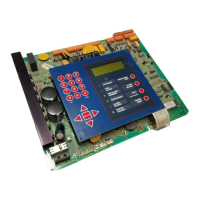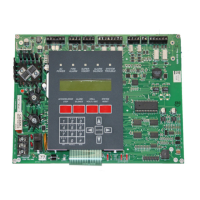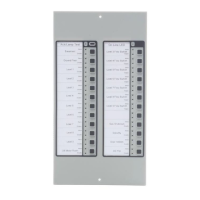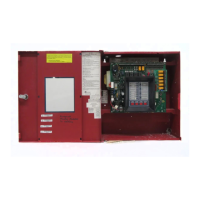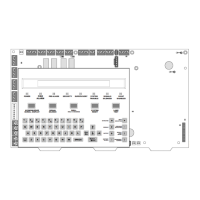1-50
Installation 15088:J 10/22/99
11 No connection
10 No connection
9 No connection
8 Normally open contact
7 Normally closed contact
6 Common
5
4 No connection
Normally open contact
2 Normally closed contact
1 Common
}
}
P4
See Appendix A for
contact ratings
Section 3.7 The Central Processing Unit (CPU-2020, CPU-2)
Figure 3.7-1 CPU Alarm and Trouble Contacts
System
Trouble/
Supervisory/
Security
Contacts
General
Alarm
Contacts
Connect Terminal 5 of
P4 to chassis ground
via cable (Part
Number 71073)
NOTE
Contacts may be connected to power-limited or nonpower-limited sources of power. Refer to the power-limited
information label located inside the door of the FACP. All circuits that are connected to nonpower-limited sources
of power must be identified on this label.
The Central Processing Unit is the heart of the system (refer to Figure 3.7-1). This unit directs all communications
between modules and monitors all modules in the system for removal or failure. The CPU maintains all programmable
system parameters (except alphanumeric information) in nonvolatile memory to protect the data if primary and
secondary power is removed (provided the board and all associated cabling is handled with proper precaution). The
CPU executes all control-by-event programs for specific action in response to an alarm condition. A real-time clock
provides time annotation on the display(s), history file, and printer. The CPU provides one set of Form-C general
alarm contacts and one set of Form-C system trouble contacts. The Form-C general
alarm
contacts will transfer during
the presence of one or more fire alarm signals. The Form-C system
trouble
contacts will transfer during any security
alarm supervisory signal or trouble condition. The Form-C trouble contacts will not transfer when both primary and
secondary power is lost. When such transfer is required, use a separate, listed power supervisory relay. Only one
CPU is required per AM2020/AFP1010 system.
Note: Due to the proximity of the alarm and trouble contacts to CPU-based system control functions, only circuits that
are unlikely to produce any electrical noise should be connected to the contacts. If a noise-generating device is
connected to these contacts, system operation problems might be encountered.
www.PDF-Zoo.com

